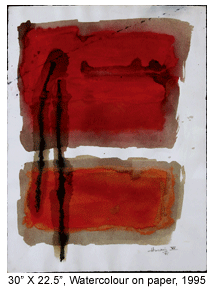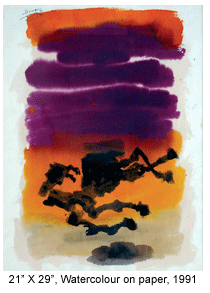- Prelude
- Editorial
- ...Where ever I stumble, let painting lie before me....
- ...Colour guides in its own direction...
- Abstract Art: Popular Myths and History
- Abstract Rhetoric:
- Ram Kumar: A transition from figurative to abstract
- I walk the line
- Exploring a twilight zone
- Articulating the Abstract voice from Madhya Pradesh
- Perception of Abstract in forms
- Confronting Cultures: The Dialectic of Abstraction in Bengal Art
- K.C.S. Paniker and his Words and Symbols
- Dialectics of Abstract Art and Its Indigenous Identity
- Between Ambivalence and Criticism: Why Abstraction?
- Notations and Rhythm in Space: Sushen Ghosh
- Victorian Era: Eclectic Furniture
- Patek Philippe : an overview
- The “Theme Pandals” of Durga Pujo: An Unexplored Discourse
- Musings on Music
- Butterflies in the stomach… still
- Contemporary Art Market Report 2009-10
- Artist Index and Statistics
- Auction Reports
- Recent works of Pavan kumar D. - In the Journey of Learning things
- Narrating “with a pinch of salt” Paintings of K.P.Reji
- Reclaiming an artist of true calibre
- Musings from Chennai
- An Annual Homage..
- Art Events Kolkata: September-October 2010
- Mumbai Art Sighting
- Art Bengaluru
- Unveiling the next in line
- Preview
- In the News
- Sotheby’s : Important Watches Hong Kong
ART news & views
Exploring a twilight zone
Volume: 3 Issue No: 10 Month: 11 Year: 2010
 M.F.Husain is better known as a figurative painter than as an abstractionist. His figures emerge out of the reality that engulfs the artist, critiquing what appears unpleasant and inaesthetic to him. Since the early days of his creative life in the 1940s he has been eclectic, experimenting with forms and structures from a wide range of sources. I
M.F.Husain is better known as a figurative painter than as an abstractionist. His figures emerge out of the reality that engulfs the artist, critiquing what appears unpleasant and inaesthetic to him. Since the early days of his creative life in the 1940s he has been eclectic, experimenting with forms and structures from a wide range of sources. I t has been a persistent effort on the artist's part to recast naturalistic structures in new two-dimensional format. In order to achieve this transformation, he has internalised forms from various sources, national and international. He has unhesitatingly assimilated material from various sources like Indian classical and folk tradition, from Sufi religion and from various mythical literature. In the matter of artistic technique he used Chinese ink and brush techniques and British water colours with equal equanimity.
t has been a persistent effort on the artist's part to recast naturalistic structures in new two-dimensional format. In order to achieve this transformation, he has internalised forms from various sources, national and international. He has unhesitatingly assimilated material from various sources like Indian classical and folk tradition, from Sufi religion and from various mythical literature. In the matter of artistic technique he used Chinese ink and brush techniques and British water colours with equal equanimity.  The forms that encounter us in his works have evolved from the forms in Italian renaissance art as well as forms of European modernist artists like Picasso.
The forms that encounter us in his works have evolved from the forms in Italian renaissance art as well as forms of European modernist artists like Picasso.
As I said, Husain was opposed to naturalistic painting. In his creative journey, he has very often swerved away from recognisable natural elements to arrive at non-figurative or abstract formation. His art belongs to the twilight area between the figurative and non-figurative. In many of his works, recognisable figures dissolve into linear or colour-field abstractions.  As early as 1959, he painted in oil a piece titled 'Bharatnatyam', where, he came out with his trademark style of figuration which dissolved into and within a geometric chromatic structure in such a way that bordered on abstraction. 'Bangalore Races' of 1986 is also a study in the journey from figuration to abstraction with the depiction of running horses in a whirl of extreme dynamism. 'Draupadi on Dice, Mahabharata' is yet another case in point. 'Bycycle in Beijing' of 1984 evinces a linear abstraction where Chinese ink and brush technique have played vital roles. This Chinese experience has been the source of many of his later abstractions from landscape elements. Many of his landscapes of the 1980s like 'Theorem of a landscape' or 'Landscape XIII' despite subtle suggestions of figures are exercises in abstraction.
As early as 1959, he painted in oil a piece titled 'Bharatnatyam', where, he came out with his trademark style of figuration which dissolved into and within a geometric chromatic structure in such a way that bordered on abstraction. 'Bangalore Races' of 1986 is also a study in the journey from figuration to abstraction with the depiction of running horses in a whirl of extreme dynamism. 'Draupadi on Dice, Mahabharata' is yet another case in point. 'Bycycle in Beijing' of 1984 evinces a linear abstraction where Chinese ink and brush technique have played vital roles. This Chinese experience has been the source of many of his later abstractions from landscape elements. Many of his landscapes of the 1980s like 'Theorem of a landscape' or 'Landscape XIII' despite subtle suggestions of figures are exercises in abstraction.  In 1987 he made a series on 'The Raman Effect' as a tribute to the scientist Raman in which he worked extensively on geometrical abstractions. All these examples suggest that Husain arrives at abstraction through a very individualistic process of simplification. For him abstraction is a means, but not an end in itself.
In 1987 he made a series on 'The Raman Effect' as a tribute to the scientist Raman in which he worked extensively on geometrical abstractions. All these examples suggest that Husain arrives at abstraction through a very individualistic process of simplification. For him abstraction is a means, but not an end in itself.
A few examples of his abstract or near-abstract paintings reproduced here also bear out this fact. The earliest one was done in 1962. Actually this oil on canvas is an abstracted landscape. Within the green background there are various shades of brown brush strokes suggesting rows of village hutments, entirely transformed into abstract colour-field.  The water colour of 1991 is actually a transformed image of horse lying down in an abstracted background. Pain of the fallen horse is the theme here, but the transformation has led to some sort of abstraction. Another water colour of 1991 where in white background red, brown and yellow colour-fields are scattered provides an example of pure abstraction, though the chromatic display suggests a cloudscape during sunrise or sunset, The other three works, all executed in water colour and done in 1995, do also exemplify Husain's transactions with pure abstraction. The first one of these, done in a vertical rectangular format, shows falling bloodstains suggesting a pathetic humanitarian environment.
The water colour of 1991 is actually a transformed image of horse lying down in an abstracted background. Pain of the fallen horse is the theme here, but the transformation has led to some sort of abstraction. Another water colour of 1991 where in white background red, brown and yellow colour-fields are scattered provides an example of pure abstraction, though the chromatic display suggests a cloudscape during sunrise or sunset, The other three works, all executed in water colour and done in 1995, do also exemplify Husain's transactions with pure abstraction. The first one of these, done in a vertical rectangular format, shows falling bloodstains suggesting a pathetic humanitarian environment.
The special feature of Husain's abstraction is that it contains subtle human elements, some feelings of life, for which Husain is known.